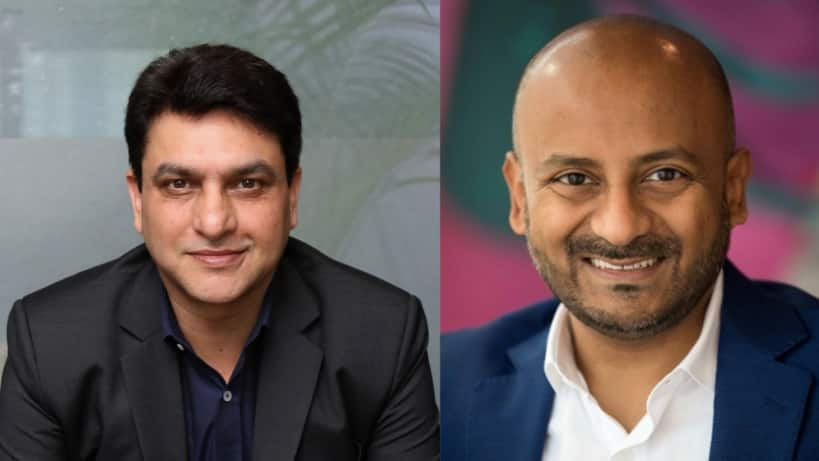Legacy broadcasters are in a race against time, and attention. But can emotional equity, clever content strategy, and omnichannel ambition future-proof its relevance in the streaming-first era?

Ashish Sehgal - Chief Growth Officer, Kartik Mahadev - Chief Marketing Officer at ZEEl (Source: prhandout)
Few brands in Indian media can claim the kind of cultural shelf life that ZEE enjoys. Yet in today’s fragmented, multi-platform landscape, legacy is no longer leveraged, unless it’s actively reimagined. ZEE’s recent rebrand to simply “Z” is more than a cosmetic shift. It’s a signal: the company doesn’t just want to be remembered for its past, it wants to compete in the now.
And it’s trying to do so amid financial headwinds. The company posted a net profit of Rs. 144 crore for Q1 FY26, up 14% year-on-year, even as total revenue fell 14% to Rs. 1,825 crore. The reason? A tight focus on efficiency—operating expenses dropped nearly 15% YoY, helping ZEE maintain profitability despite softer ad and subscription markets.
So while the emotional storytelling and cultural resonance are getting a fresh coat of paint, the bigger story is this: ZEE is trying to prove that it can be a leaner, sharper, and more platform-ready player, without losing the heart that made it a household name.
So what’s behind this shift, and does it go deeper than a new logo?
We spoke to Kartik Mahadev, Chief Marketing Officer – Content Business (TV & Digital) and Ashish Sehgal, Chief Growth Officer – Advertisement Revenue at ZEE, to understand how India’s media veteran is re-architecting its future.
At first glance, the rebrand might seem like a cosmetic reset. But Mahadev is quick to clarify: “The ‘Z’ identity is both a nod to our legacy and a leap toward an omni-platform future.”
In a country where content is consumed across languages, screens, and formats, ZEE is trying to shift from being a “TV brand” to what Mahadev calls a “daily companion” for 200 million households. “Aapka Apna ZEE,” the brand’s new campaign, is a rallying cry for relevance, anchored in emotional memory but designed to scale across platforms.
In a world chasing the next bingeable hit, ZEE is placing a slower, deeper bet: building content IPs with regional resonance and national ambition. Mahadev calls it a “multi-platform strategy that builds content brands native to language markets.” The goal is to create formats that live and breathe across TV, OTT, and social media, like Zee Cine Awards or simulcast formats on ZEE5 and broadcast.
This is more than just syndication. It’s about building stories that hold emotional currency, whether they’re watched at 9 pm on TV or on a phone in transit. “Each IP is crafted to thrive across TV, OTT, and social ecosystems,” Mahadev says.
ZEE is also redefining what it means to partner with brands. For decades, broadcasters sold inventory. Today, they need to sell context. “We collaborate with brands to deliver integrated solutions anchored in cultural relevance and audience engagement,” says Mahadev.
One example is “Fantertainment”—a framework for blending fan culture with entertainment via award shows, character integrations, or fan-led contests. It’s not just about selling ads anymore. It’s about selling stories that carry brand narratives.
In a world flooded with dashboards, Mahadev argues that ZEE’s strength lies in how it interprets data culturally. “Our approach goes beyond listening to deep dialoguing with the consumer,” he says. This means understanding not just what content performs, but why it connects.
Initiatives like Friday Box Office on ZEE5 or TV+Z5 simulcasts weren’t just tech experiments. They were decisions informed by how viewers move between platforms. And crucially, by how different Indias—urban, rural, Hindi-speaking, Tamil, Marathi—consume differently.
ZEE’s marketing, content, and tech teams aren’t working in silos, Mahadev insists. “We’re anchored in a shared purpose: to create stories that resonate deeply and experiences that are scalable.” Campaigns like Aapka Apna ZEE or Dilfluencer—where beloved TV characters act as brand advocates—are examples of that cohesion.
This may sound like textbook integration, but it’s crucial in a business that often sees marketing and content tug in opposite directions.
But legacy, emotion, and even data don’t pay the bills unless monetisation is rethought. That’s where Ashish Sehgal steps in.
“ZEE is addressing monetisation challenges through a strategically balanced hybrid approach that harnesses the scale of broadcast and the precision of digital platforms,” Sehgal explained.
While TV remains a reliable engine through events and high-impact shows, the digital side is being fortified via live-streamed finales, platform-exclusive content, and innovations in ad delivery like dynamic insertion. “We’re creating smaller but effective packages for retail advertisers to drive both awareness and conversion,” he added.
Initiatives like Z RISE, a multi-city retail connect program, are designed to attract advertisers who might not have considered omnichannel campaigns before.
One of ZEE’s biggest assets is its ability to balance mass reach with regional precision. “The ‘Aapka Apna ZEE’ campaign itself was crafted in seven languages,” Sehgal says, “with storylines tailored to regional sensibilities, yet unified under a national emotional theme.”
ZEE isn’t just selling GRPs. It’s pitching cultural fluency and community affinity to brands looking for emotional resonance. “Our regional campaigns act as test beds where messaging is refined using real audience insights and cultural nuance,” he adds.
ZEE is also diversifying revenue through newer formats. From co-created brand IPs to on-ground events, sports, and digital-first collaborations, the goal is to move beyond traditional monetisation.
Sehgal points to Dilfluencers (characters as brand advocates), content-to-commerce experiments, and syndication as areas of expansion. “We’re creating more agile, outcome-based commercial models,” he said, hinting at a more tech-and-performance-oriented future for a company once defined by appointment viewing.
ZEE’s rebrand comes at a time when streaming fatigue is setting in, ad budgets are tightening, and regulatory winds are shifting. It’s betting on emotional equity, cultural fluency, and smart integrations to reinvent itself for the future.
Is it enough?
In a landscape where attention is platform-agnostic and loyalty is elusive, ZEE’s strategy—rooted in emotional storytelling and operational coherence—offers a playbook that other legacy players might soon follow. But brand nostalgia alone won’t be enough. Execution, agility, and real audience love across mediums will determine whether ‘Z’ stands for ZEE’s next leap—or just another pivot in progress.
By continuing you agree to our Privacy Policy & Terms & Conditions
